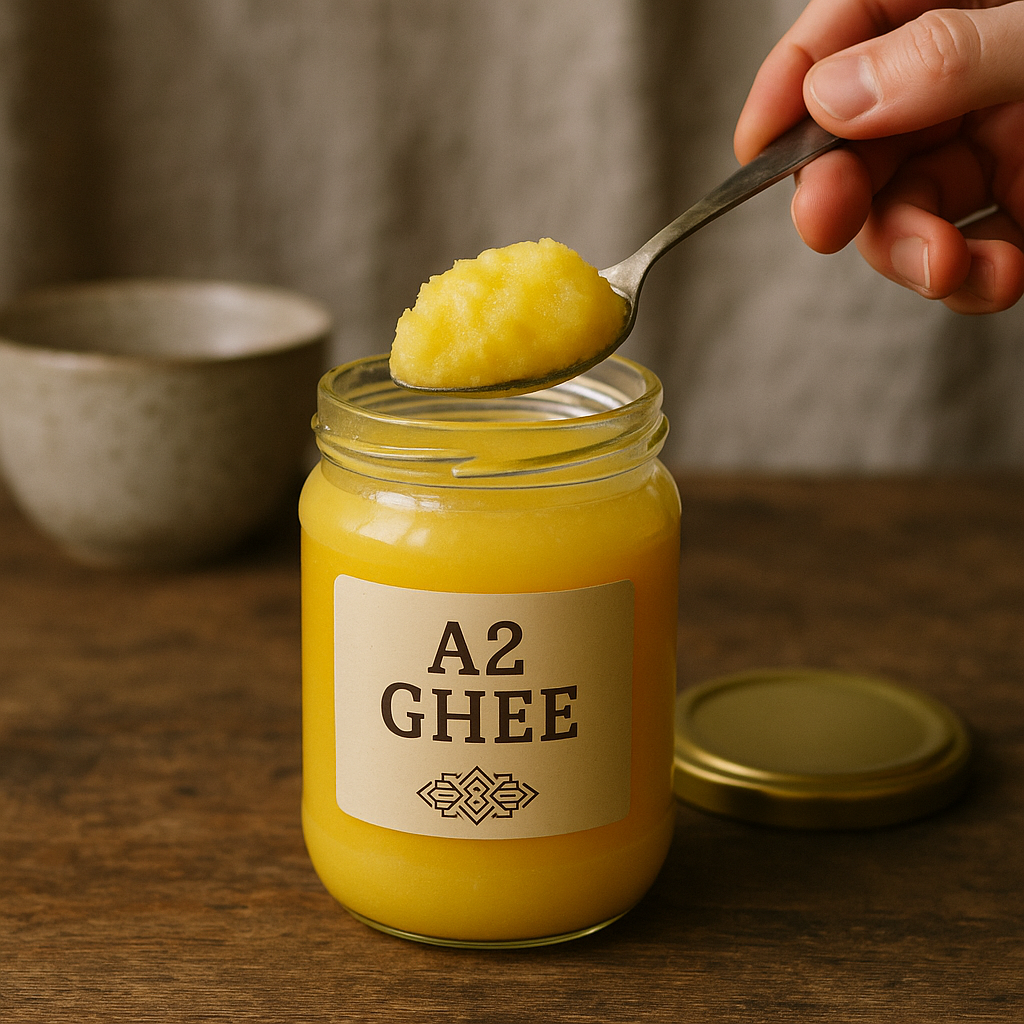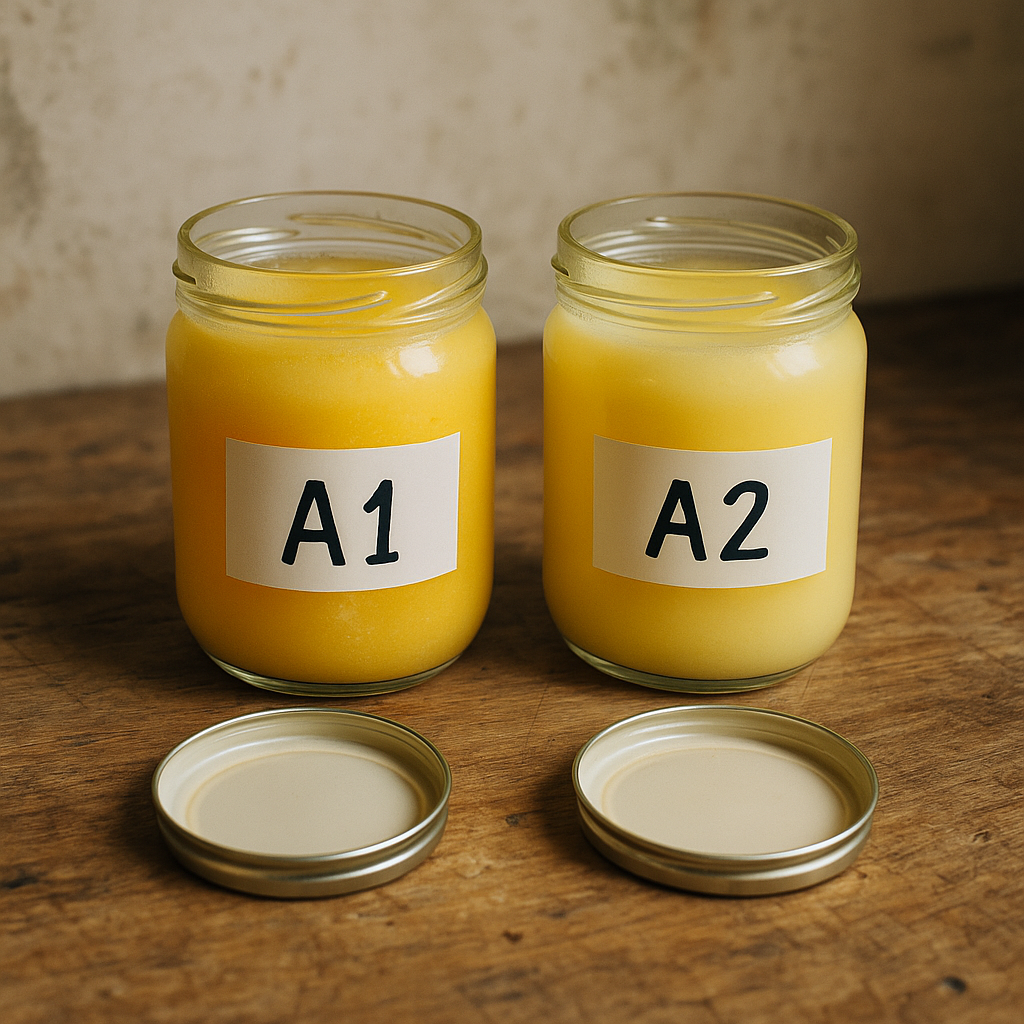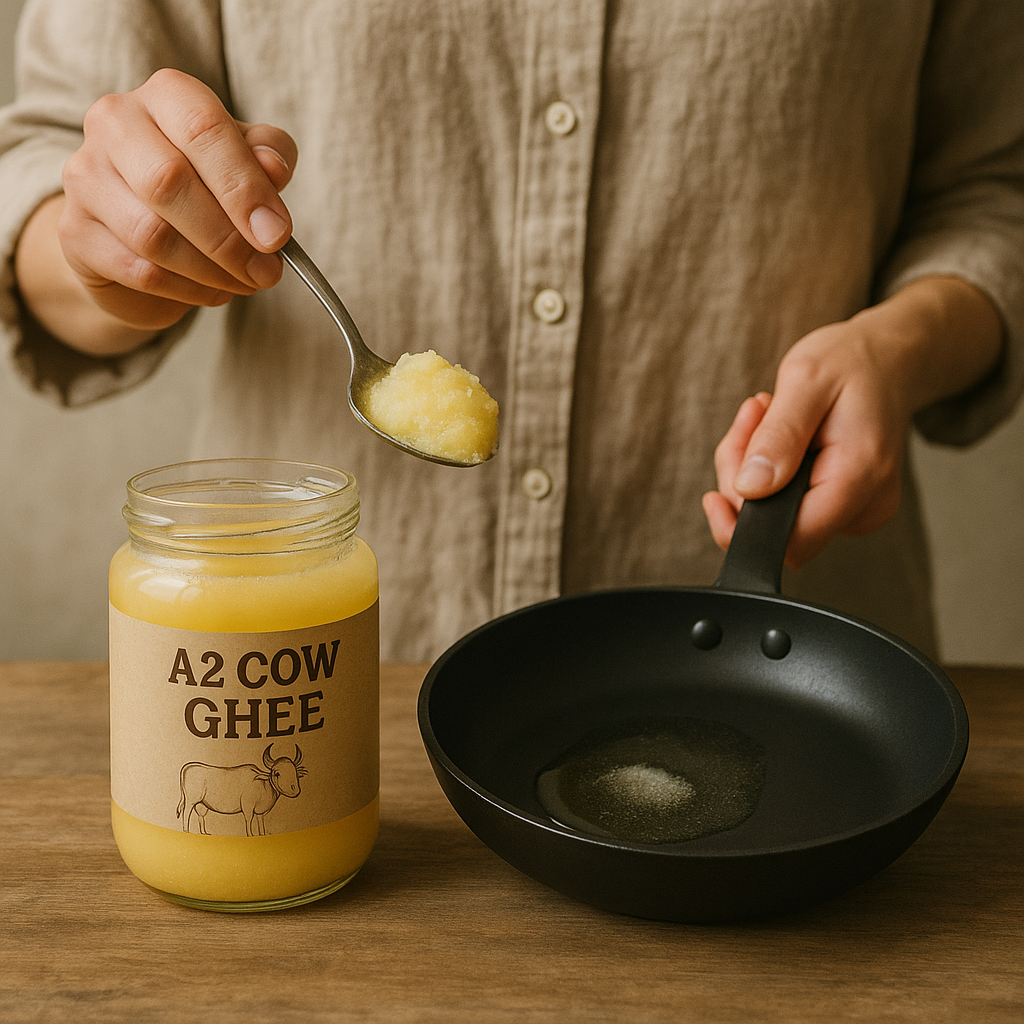Ask Ayurvedic doctor a question and get a consultation online on the problem of your concern in a free or paid mode. More than 2,000 experienced doctors work and wait for your questions on our site and help users to solve their health problems every day.
Shop Now in Our Store
What Is A2 Ghee: Ayurvedic Meaning, Benefits, and How It’s Made

A2 ghee has become a bit of a buzzword lately — and for good reason. But what is A2 ghee exactly? And why are so many people swapping their regular cooking fats and oils for this golden, fragrant substance? The term might sound scientific, but at its core, A2 ghee is rooted in ancient tradition. In Ayurveda, it’s more than just a kitchen staple — it’s medicine, nourishment, and even a spiritual ingredient. If you’re curious about the A2 ghee meaning, how it’s made, or the benefits of A2 cow ghee, you're in the right place. Let’s break it all down in a simple, no-nonsense way that makes sense, even if you're totally new to the world of ghee.
We'll also unpack the difference between A1 and A2 ghee, how ghee is traditionally made, and the many ways you can use it in daily life. Spoiler: it's not just for cooking!

What Is A2 Ghee: Meaning and Ayurvedic Perspective
If you’re wondering “What is A2 ghee?” — here's a straightforward way to look at it.
A2 ghee means clarified butter made from the milk of cows that produce the A2 beta-casein protein — typically native Indian breeds like Gir, Sahiwal, or Red Sindhi. These cows haven’t been genetically altered and their milk is considered more digestible and closer to what our ancestors consumed.
In Ayurveda, A2 cow ghee means more than just fat. It's called “ghrita” and is revered for its ability to nourish ojas — the vital energy believed to govern immunity, vitality, and mental clarity. Ayurvedic texts describe ghee as a sattvic food — calming, nourishing, and purifying. It’s used in cooking, herbal medicine, massage, and even sacred rituals.
Unlike other fats, ghee doesn't increase ama (toxins), according to Ayurveda. Instead, it supports agni — your digestive fire. That’s why many Ayurvedic doctors recommend taking a spoonful of warm ghee in the morning with herbs or on an empty stomach.

A2 vs A1 Ghee: Key Differences
Let’s get into the real stuff: the difference between A1 and A2 ghee. The main distinction lies in the protein type in the milk used.
-
A1 Ghee is made from milk of cows like Holstein and Jersey, common in Western dairy farms. It contains A1 beta-casein, which some studies suggest may cause inflammation or digestive discomfort in sensitive individuals.
-
A2 Ghee, on the other hand, comes from indigenous cows and contains only the A2 protein, which many believe is easier on the stomach and more in tune with human digestion.
There’s still ongoing debate in the scientific world, but anecdotal evidence and Ayurvedic tradition point strongly toward the benefits of A2 milk and ghee.
What A2 Cow Ghee Actually Means
So when someone asks, “What is A2 cow ghee?”, the simple answer is: it’s ghee made from A2 milk — and made properly, using traditional methods.
But here's where it gets tricky — not all brands that slap “A2” on their label follow authentic practices. Real A2 ghee is usually made via the Bilona method (we’ll get into that next), from grass-fed cows, with ethical milking processes.
Oh, and just to clear this up: A2 ghee means more than a trendy label. It's about purity, tradition, and health — not just marketing hype.
How A2 Ghee Is Made: Traditional Preparation Methods
So now that we’ve unpacked what A2 ghee means, let’s take a look at how it’s actually made — the real way.
Authentic A2 ghee is crafted using the Bilona method, an age-old technique mentioned in Ayurvedic texts. It's a slow, careful process that prioritizes quality over quantity. Here's how it generally goes:
-
Milking Indigenous A2 Cows – It starts with ethically sourced milk from native Indian cows like Gir or Sahiwal. These cows are usually free-grazing, grass-fed, and not subjected to hormone injections or harsh conditions.
-
Curd Formation – Unlike commercial ghee, which often skips steps, A2 ghee is made by converting milk into curd (yogurt) first.
-
Hand Churning – The curd is churned using a wooden churner (traditionally called bilona) to separate the butter. This step is crucial — it's done slowly and mindfully, usually in clockwise and counterclockwise rotations.
-
Heating the Butter – The separated butter is then heated on a low flame to remove moisture. This slow-cooking stage enhances the aroma, deepens the color, and preserves nutrients.
What you're left with is golden, aromatic ghee that's rich in good fats, vitamins, and bioactive compounds.
And yes — this process is labor-intensive and time-consuming. That’s one of the reasons why A2 ghee is so expensive. It’s not mass-produced; it’s lovingly made. You could say it’s the craft beer of fats!

Health Benefits of A2 Ghee
Now let’s talk results. Why should you even bother replacing your usual cooking oil or butter with this “fancy” ghee? Turns out, the benefits of A2 ghee (and especially the benefits of A2 cow ghee) are pretty impressive.
For Digestion, Brain, and Immunity
First off, A2 ghee is gut-friendly. Unlike many modern oils that irritate the stomach lining, ghee soothes it. The short-chain fatty acids like butyrate present in A2 ghee support healthy digestion and even help heal the gut wall. If you’ve ever dealt with bloating or acidity, a spoon of warm ghee in your dal or rice can really help.
Brain-wise, A2 ghee is like rocket fuel. Rich in omega-3s and healthy cholesterol, it nourishes brain cells, improves memory, and supports emotional balance. Ayurveda even recommends it during exams for students — wild, right?
And don’t forget immunity. The saturated fats in ghee help absorb fat-soluble vitamins (A, D, E, and K), which play a big role in immune health. Plus, the antioxidants in ghee help reduce oxidative stress, which is a fancy way of saying they help your body chill out and fight disease.
For Children, Skin, and Aging Support
Kids need good fats for growth — not sugary snacks. A2 cow ghee provides the right kind of fats for brain and bone development. Add a little to their rotis or warm milk — it’s an old trick that still works.
And your skin? Ghee isn’t just good inside. Applied topically, it moisturizes, heals cracked lips, and even lightens scars. Some people swear by it as a natural anti-aging cream. (Fair warning: don’t expect miracles overnight, but hey, it's natural.)
As for aging, A2 ghee’s antioxidant profile helps fight cellular damage. It also lubricates joints and supports hormonal balance. Honestly, it’s like nature’s multivitamin in a spoon.
Oh, and yes — types of ghee matter. Clarified butter might seem the same on the shelf, but the source, process, and cow breed change everything. A2 is cleaner, gentler, and more aligned with how our bodies actually work.
How to Use and Store A2 Ghee in Daily Diet
So you’ve got your jar of A2 ghee. Now what?
Luckily, ghee is made from something so natural and stable — it’s incredibly versatile. You can cook with it, eat it straight, or even apply it on your skin. It has a high smoke point (around 485°F / 250°C), which makes it safer than most oils for frying or sautéing.
Here are some simple, everyday ways to use A2 ghee:
-
Cooking & Frying: Swap it for oil in stir-fries, curries, or dosa batter. It adds a buttery aroma that just hits different.
-
Topping Hot Foods: Drizzle it over rice, lentils, roti, or khichdi. One teaspoon goes a long way.
-
Morning Ritual: Some Ayurvedic practices recommend starting your day with a spoonful of ghee on an empty stomach — often mixed with turmeric or warm water.
-
In Coffee/Tea: Yep, “bulletproof” ghee coffee is a thing. Add half a teaspoon to your morning brew for that creamy energy boost.
-
Skin Care: Rub a little on chapped lips or dry elbows. Sounds weird, works wonders.
How to Store It?
Store your A2 ghee in a cool, dry place — no fridge needed. Keep it tightly sealed and use a clean, dry spoon each time. Real ghee lasts for months, even years, without spoiling if kept properly.
Conclusion
So — let’s tie it all together.
A2 ghee means more than just a food trend. It’s a time-honored, nutrient-rich fat with deep roots in Ayurvedic healing. From helping with digestion and brain function to boosting immunity and supporting glowing skin, the benefits of A2 cow ghee are wide-ranging.
Understanding what A2 ghee is — and how it's different from its A1 counterpart — gives you the power to make healthier, more informed choices for yourself and your family. Whether you’re using it to cook, nourish, or heal, real A2 ghee stands out for its purity, traditional roots, and health value.
And look, perfection isn’t the goal here. Just swapping out a few processed fats with something clean and nutrient-dense can make a real difference. That’s the beauty of going back to basics.
FAQs
Q: Is A2 ghee better than regular ghee?
A: Generally, yes. A2 ghee is made from milk of native cows with A2 protein, which many people find easier to digest. Regular ghee may be made from A1 milk, which some claim causes inflammation or bloating.
Q: Why is A2 ghee so expensive?
A: Because of how it’s made. It uses milk from native Indian cows, involves traditional Bilona processing, and yields less volume. It’s not mass-produced, and the quality control is much tighter.
Q: What are the side effects of A2 ghee?
A: Unless you're allergic to dairy or consuming it in ridiculously large quantities, side effects are rare. That said, it's calorie-dense, so moderation matters. Also, always make sure it's real A2 ghee — some brands fake it.
Final Thoughts
If you’ve made it this far — hats off. Clearly, you care about what goes into your body, and that’s something to be proud of.
Whether you’re here because you heard about what is A2 cow ghee from a friend, or you’re just trying to clean up your pantry — this golden stuff is a small but powerful upgrade. Try it for a week. Add a spoon to your rice, your tea, or your skin routine. Feel the difference. And hey, maybe pass this along to someone who’s still cooking with random seed oils 😬.
Want to learn more or grab a jar of authentic A2 ghee? Check out trusted local farms or small-batch producers near you — or support ethical Indian dairy brands online.
👉 Ready to make the switch? Start with one spoon. Your body will thank you.
This article is checked by the current qualified Dr Sujal Patil and can be considered a reliable source of information for users of the site.

